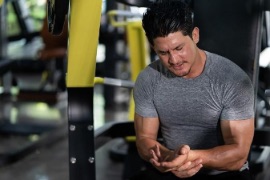 A repetitive strain injury develops when tendons, muscles, ligaments, or nerves in a joint become irritated due to repetitive activities. This injury is also known as non-specific upper limb pain or work-related upper limb disorder. Other conditions such as carpal tunnel syndrome, tendonitis, tennis elbow (lateral epicondylitis), Guyon canal syndrome, and cubital tunnel syndrome are referred to as repetitive strain injuries.
A repetitive strain injury develops when tendons, muscles, ligaments, or nerves in a joint become irritated due to repetitive activities. This injury is also known as non-specific upper limb pain or work-related upper limb disorder. Other conditions such as carpal tunnel syndrome, tendonitis, tennis elbow (lateral epicondylitis), Guyon canal syndrome, and cubital tunnel syndrome are referred to as repetitive strain injuries.
The most commonly affected joints are the hands, wrists, forearms, elbows, shoulders, and neck. These areas are prone to injury because they are frequently used. Workers such as stockers, assembly line personnel, cashiers, and office staff who type at a desk for extended periods often experience this issue.
Repetitive strain injuries are also associated with certain types of sports (e.g., basketball, golf, baseball, or tennis). However, any type of activity that involves repeating the same movement numerous times increases the risk of straining a muscle, tendon, or ligament due to overuse. Also, with aging our muscles become weaker, however, the tasks that often cause repetitive injuries do not change which makes us prone to these types of injuries.
Symptoms that indicate joint overuse or improper technique include:
- Tenderness
- Joint stiffness
- Burning sensations
- Reduced mobility of the joint
- Muscle cramping or weakness
- A dull ache in the affected region
- Tingling (pins and needles sensation)
Treatment for a repetitive strain injury often depends on the severity of the tissue damage. A minor injury can be treated with over-the-counter pain relievers such as naproxen, aspirin, or ibuprofen, which are nonsteroidal anti-inflammatory drugs (NSAIDs). Temporarily refraining from the activity that caused the strain also helps the joint begin to heal.
Certain approaches have also proven to be more effective than others at managing different repetitive strain injuries. For example, some people with tennis elbow experience relief after using topical or oral NSAIDS, while the use of a wrist brace may be more beneficial for individuals with carpal tunnel syndrome. For moderate to severe injuries that cause constant pain or discomfort during daily activities, physiotherapy may be necessary.
This therapeutic approach focuses on helping individuals experience improved mobility, increased strength, and reduced pain through guided stretching techniques and strengthening routines. After conducting a thorough assessment, a physiotherapist develops a specialized treatment regimen that aims at:
- Reducing tenderness, stiffness, and weakness
- Increasing the strength of damaged ligaments, muscles, or tendons
- Restoring mobility and full range of motion in the affected joint
Also, with people working from home due to the COVID pandemic on a permanent or hybrid basis, workstation setup has become more important to help alleviate repetitive strain injuries and manage poor posture. This has been seen with the increasing popularity and availability of sit to stand desks so that people can change their positioning from sustained postures and augment a more favourable ergonomic set up for working.
Some manufacturing facilities are also becoming more aware of and incorporating workstation rotation, so that people are not performing the same repetitive assembly tasks all day that require the same muscles to the point of overuse. Employers are also integrating stretching breaks throughout the day.
In many cases, people who work with a physiotherapist shortly after the injury occurs avoid the need for invasive procedures, including surgery.
If you are experiencing recurring pain due to a repetitive strain injury, it is important to consider physiotherapy as a treatment option. The highly skilled experts at In Balance Physiotherapy can assist you during your path to recovery and help you identify habits or daily activities that may have caused the injury. Learning the appropriate way to modify your movements can reduce the risk of experiencing this issue in the future. Schedule a consultation today.
References
1. van Tulder M, Malmivaara A, Koes B. Repetitive strain injury. Lancet. 2007; 369(9575):1815-22.
2. da Costa JT, Baptista JS, Vaz M. Incidence and prevalence of upper-limb work related musculoskeletal disorders: A systematic review. Work. 2015; 51(4):635-44.
3. Tjepkema M. Repetitive strain injury. Health Rep. 2003; 14(4):11-30.
4. Van Eijsden-Besseling MD, van Attekum A, de Bie RA, Staal JB. Pain catastrophizing and lower physical fitness in a sample of computer screen workers with early non-specific upper limb disorders: a case-control study. Ind Health. 2010; 48(6):818-23.
5. Ratzlaff CR, Gillies JH, Koehoorn MW. Work-related repetitive strain injury and leisure-time physical activity. Arthritis Rheum. 2007; 57(3):495-500.
6. Helliwell PS, Taylor WJ. Repetitive strain injury. Postgrad Med J. 2004 Aug;80(946):438-43.









